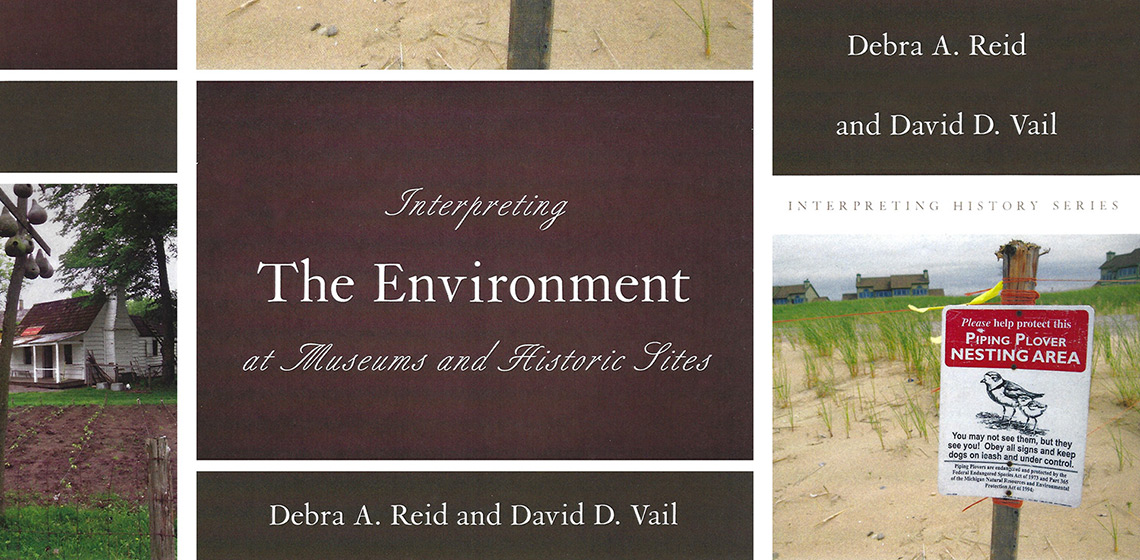
Interpreting the Environment at Museums and Historic Sites is a textbook and a call to action. In the midst of the Anthropocene, Debra A. Reid and David D. Vail argue, museums and conservation areas should attend to their environmental assets, tell environmental stories, and take an activist role in encouraging better stewardship.
While the authors call out to a very broad audience, their real goal seems to be to broaden the reach of some basic concepts within the community of small museums in the United States. Part of a series edited by the American Association for State and Local History, which contains some excellent texts, this book is steeped in the history, culture, and regulatory environment that pertains to these institutions and is less generalizable than some other volumes in the series. That said, the fundamental message of the text is relevant everywhere. As the authors point out, with increasing attention paid to climate change and environmental sciences, the ground is fertile for improved attention to environments and environmentalism.
The first half of the book is a fairly straightforward primer on interpretive practices. Protected natural sites are invited into the same conversation as more traditionally historic sites, and the authors encourage each type of site to increase attention to topics of interest across disciplinary lines by including more historical materials at nature-first sites, and more natural history at history-forward sites - and more STEM in both cases. They provide a four-point toolkit which suggests identifying connections, increasing access and participation, and leaving the visitor with new ways to think about the environment. Importantly, the authors advocate for cataloging environmental assets as artifacts, to track and avoid deterioration but also as a way to ensure that these assets are not taken for granted institutionally.
The second half of the text is a collection of bite-sized chapters on specific interpretive scenarios organized by theme, including: working environments, water, power, food, travel and trade, building, and “natural landscapes.” These latter chapters are supported by contributions from an array of museum professionals. The case studies are a bit uneven, and many suffer from the usual difficulties involved in encapsulating live interpretation - an inherently oral, relational, and experiential medium - in formal and fixed text (or scripts, for that matter).
As a grab-bag of potential approaches to identifying stories worth telling, these chapters are useful and reveal the sensitivities of experienced contributors to stories that work for real audiences. A variety of interpretive approaches are covered, including some reference to experiential and experimental archaeology, mainly in Chapter 4 (“Creating Working Environments”). I was pleased to see both steam traction and oil-pull engines, which are often skipped over in industrialization narratives, included in Chapter 6. Chapter 5 stood out, with two very effective case studies, which suggest including expertise from the sciences and data-driven approaches to underpin interpretation, respectively. Chapter 10, on “natural landscapes” was more problematic, and would have benefited from a greater awareness of pre-contact histories.
The book addresses existing biases in American Studies and small museums, but does not completely escape them. Citations pertaining to settler sites, land-use, and environments are substantially more voluminous and up to date than those pertaining to Indigenous contexts. None of the contributors appears to specialize in Indigenous studies, which seems a significant oversight for a book on interpreting North American environments.
Experimental and experiential archaeologists who rely heavily on an intimate awareness of the environments they interpret will likely have encountered most of these ideas before. However, the text is likely to be useful in prompting discussion and convincing others to place more value on interpreting environments and environmentalism, especially for its core audiences in North America.
Book Information:
Reid, D. A. and Vail, D. D., 2019. Interpreting the Environment at Museums and Historic Sites. London: Roman and Littlefield. 205 pages
Business & Economics / Museum Administration & Museology, Nature / Environmental Conservation & Protection
978-1-5381-1548-0 | Hardback | $95.00
978-1-5381-1549-7 | Paperback | $42.00
978-1-5381-1550-3 | eBook | $39.50